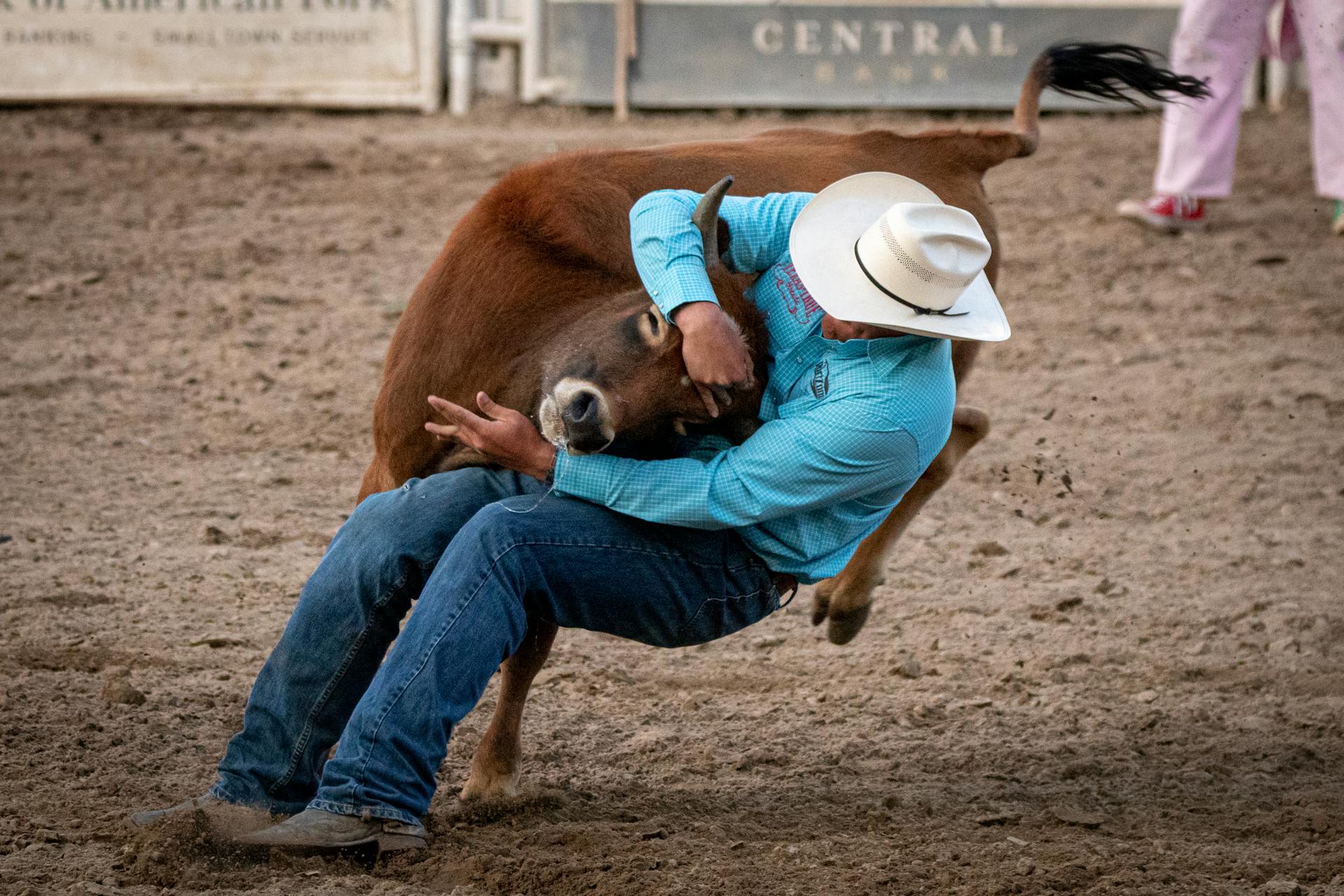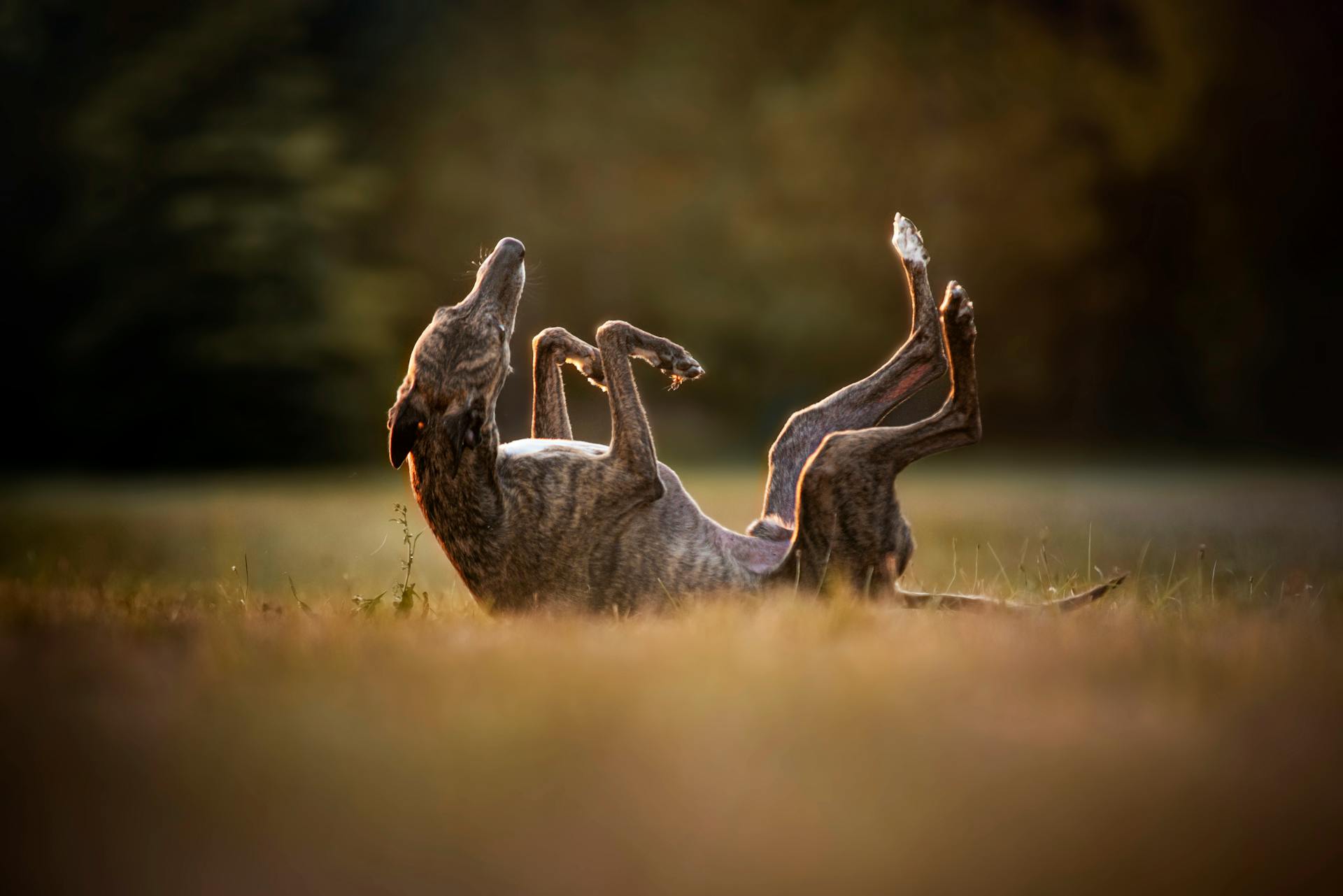
So you're considering bringing a Brindle Bull Terrier into your family? These adorable dogs are a joy to be around, but they do require some special care.
They need regular exercise, at least 30 minutes a day, to stay happy and healthy.
Brindle Bull Terriers are known for their short, easy-to-maintain coats, but they do shed a bit, especially during shedding season.
Care and Health
Brindle bull terriers are generally healthy dogs, but they can be prone to some health issues. They typically live for 12-13 years.
Deafness is a common health problem in bull terriers, with hearing loss occurring in one or both ears. Kidney disease, heart disease, and luxating patella are also potential health issues. Skin and coat problems, including allergies, can also affect bull terriers.
Here are some common health issues in bull terriers:
- Deafness
- Kidney disease
- Heart disease
- Luxating patella
- Skin and coat problems, including allergies
It's essential to provide regular exercise and mental stimulation to keep your brindle bull terrier happy and healthy. They thrive on being part of the family and need consistent positive reinforcement training to ensure they grow into well-mannered dogs.
Health Issues

Bull terriers are generally a healthy breed, but they do come with some health concerns.
Deafness is a common issue in bull terriers, with hearing loss often occurring in one or both ears. This can be a significant issue, especially if you're not aware of it.
Kidney disease, also known as hereditary nephritis, can affect bull terriers at various ages, leading to renal failure. Regular check-ups with your vet can help catch this issue early.
Heart disease, specifically mitral valve disease, is another common condition in bull terriers. This occurs when the mitral valve becomes enlarged and begins to leak, which can lead to serious health problems if left untreated.
Luxating patella, where the knee slips out of place, can be a problem for bull terriers. In mild cases, dogs can tolerate this for life, but it's essential to monitor their health closely.
Skin and coat problems, including allergies, are also common in bull terriers due to their innately sensitive skin. Regular grooming and skin checks can help prevent and identify these issues.
Here are some common health issues that bull terriers face:
- Deafness
- Kidney disease
- Heart disease (mitral valve disease)
- Luxating patella
- Skin and coat problems (allergies)
Nutritional Tips
Make sure fresh water is always available to your Bull Terrier. This is essential for their overall health and well-being.
Natural calcium is particularly important for Bull Terriers, especially when they're young, to support their growth and bone development. Their food alone may be a sufficient source, but if not, talk to your vet about other dog-safe high-calcium foods or supplements you can add during periods of rapid growth.
Bull Terriers typically love to eat, so it's best to feed them a measured amount of an age-appropriate dog food twice a day. This will help prevent overfeeding and keep them at a healthy weight.
You should always run both the type of diet and the amount by your vet to make sure you're meeting your dog's individual needs. This will ensure that your Bull Terrier is getting the right nutrients for their specific age, size, and health conditions.
Feed your Bull Terrier following the measurements outlined on their dog food label twice a day. Depending on the food, as well as your dog's age and size, the total daily amount will likely be between 1⅝ and 4¼ cups.
It's essential to choose a high-quality dog food that is approved by the Association of American Feed Control Officials (AAFCO) to ensure it provides proper nutrition and meets all necessary regulations.
Intriguing read: Could Shiba Inu Hit $1
Care and Upkeep

Bull Terriers require a secure fenced yard for exercise, as they need a lot of human interaction in the form of games, training, and leashed walks.
They're not a good candidate for dog parks, as they can be aggressive with unfamiliar animals. Bull Terriers enjoy competitive activities like agility, obedience, and scent work.
They also need protection from extreme temperatures, as they don't like cold or heat. Coat care is minimal, consisting of occasional bathing and brushing.
You should determine if a puppy has hearing issues before labeling it as disobedient, as Bull Terriers are susceptible to hearing problems.
Grooming Guide
Grooming your brindle bull terrier is a breeze, thanks to their short coats and healthy ears.
Brush your brindle bull terrier weekly with a soft-bristle brush or grooming mitt to remove loose fur and distribute skin oils.
Bull terriers tend to shed a lot, especially in the spring and fall, so be prepared to brush more frequently during these times.
Give your brindle bull terrier a bath every month or so, depending on how dirty they get.
Their nails need a trim every month, so keep an eye on them and take care of it promptly.
Check their ears at least every week for wax buildup, debris, and irritation.
Brush their teeth every day to keep them healthy and strong.
Their coat care is minimal, consisting of occasional bathing and brushing.
Bull terriers generally don't need professional grooming, you can easily take care of them at home.
Exercise and Training
Exercise is a must for your brindle bull terrier, providing at least one to two hours of physical activity per day to burn off excess energy. Multiple walks, jogs, and playtime with puzzle toys can help keep them stimulated.
Bull terriers can be stubborn, but they're highly intelligent and respond well to positive reinforcement methods during training sessions. Making training feel like a game rather than work is key to getting them to learn good behaviors.
To ensure your brindle bull terrier is well-mannered, socialize them with different people and other dogs from a young age. Positive experiences can go a long way in boosting their comfort and confidence.
Exercise

To keep your bull terrier happy and healthy, it's essential to provide at least one to two hours of exercise per day. This can be achieved through multiple walks, jogs, hikes, and playtime, such as games of fetch.
A securely fenced area or a leash is a must when taking your bull terrier outside, as they may not be friendly with strange dogs. I've seen many bull terriers in the park, and it's always a good idea to keep them on a leash.
Puzzle toys can be a great way to challenge your dog mentally, providing a fun and engaging activity. My friend's bull terrier loves puzzle toys, and it's a great way to keep them occupied.
Dog sports, such as agility and tracking, can provide both mental and physical stimulation for your bull terrier. If you're new to dog sports, consider starting with agility training, which is a great way to get your dog moving and engaged.
Limit outdoor exercise sessions in cold weather, as your bull terrier's short coat doesn't offer much protection. You can consider providing your dog with a coat or sweater to keep them warm and cozy.
Here are some dog sports to consider:
- Agility training
- Tracking
- Canine Partners
- Enroll in a mixed breed program
Training
Training your bull terrier requires patience and consistency. Proper obedience training and socialization are essential to manage your dog.
Bull terriers can be stubborn when it comes to training, but they are highly intelligent. They tend to respond best when training sessions feel like a game rather than work.
Consistency is key when training a bull terrier. You must be consistent and frequent with your training, starting at the puppy stage.
Positive reinforcement methods are a must when training a bull terrier. Reward them with treats, toys, and belly rubs to keep them motivated.
Bull terriers may not always pick up on lessons the first time around, but that's likely due to insufficient motivation and their willful nature, not a lack of intelligence.
Training sessions should be enjoyable and interesting for your bull terrier. Making them feel like a game is the key to getting them to learn good behaviors.
Suggestion: Game Bred American Pit Bull Terrier
Personality and Temperament
The brindle Bull Terrier is known for its playful and clownish personality, often described as "like a 3-year-old child in a dog suit." They're generally loving and affectionate, but also a bit mischievous and stubborn at times.
Their energy level is high, requiring regular exercise to keep them happy and healthy. A daily walk is a good start, but they may need additional physical and/or mental stimulation to be their best self.
Bull Terriers are not always dog-friendly, so early and frequent socialization is key. They can get along with people well, but may not always get along with other dogs.
One thing to keep in mind is that they can be prone to developing compulsive behaviors, like tail-chasing, if they aren't given enough attention or stimulation. Regular human companionship is a must to prevent this.
Here are some key traits to expect from a brindle Bull Terrier:
Overall, the brindle Bull Terrier is a loving and energetic companion that requires regular exercise, attention, and socialization to thrive.
General Information
The brindle bull terrier is a unique breed with a distinctive appearance.
This breed is known for its tricolor coat pattern, which features a mix of black, white, and tan colors.
Bull terriers are generally medium-sized dogs, weighing between 50-80 pounds.
Adopt or Buy
If you're looking to bring a Bull Terrier into your family, there are a few options to consider.
You can start by checking local animal shelters and rescue groups for a dog in need of a home. This is a great way to give a loving home to a dog that's already waiting.
Expect to pay around $500 to $3,500 for a puppy from a reputable breeder, although this can vary widely.
If you're interested in adopting a Bull Terrier, I recommend checking out the Bull Terrier Rescue organization.
Here are some resources to get you started:
- Bull Terrier Club of America
- Bull Terrier Rescue
History of
The Bull Terrier has a rich and fascinating history. Inhumane bloodsports involving animals became popular in Britain around the 13th century, with bull-baiting being a particularly gruesome sport.
Bull-baiting was eventually banned in the 1800s, but some people took their cruel activities underground by focusing on dogfighting instead. Dogfighting was a more discreet way to engage in these inhumane activities.

The breeders of the time wanted dogs that were more fiery and nimble, so they crossed their bulldogs with various terriers to create the bull terrier. Several breeds arose from this, including the bull terrier.
The bull terrier was initially bred for dogfighting, but as the practice diminished in the mid-1800s, breeders began to refine the breed to make them more suitable as companion dogs. They worked to create a sweeter temperament and less rugged appearance.
The American Kennel Club first recognized the breed in 1885, marking a significant milestone in the bull terrier's history.
Frequently Asked Questions
What are the 4 types of Bull Terriers?
There are four main types of Bull Terriers: Brindle, White, Red and White, and Modern-colored. Each type has its unique appearance, but they all share the same energetic and affectionate personality.
What is the best color for an English Bull Terrier?
For an English Bull Terrier, the best color is brindle, with black brindle being the preferred choice.
Featured Images: pexels.com


